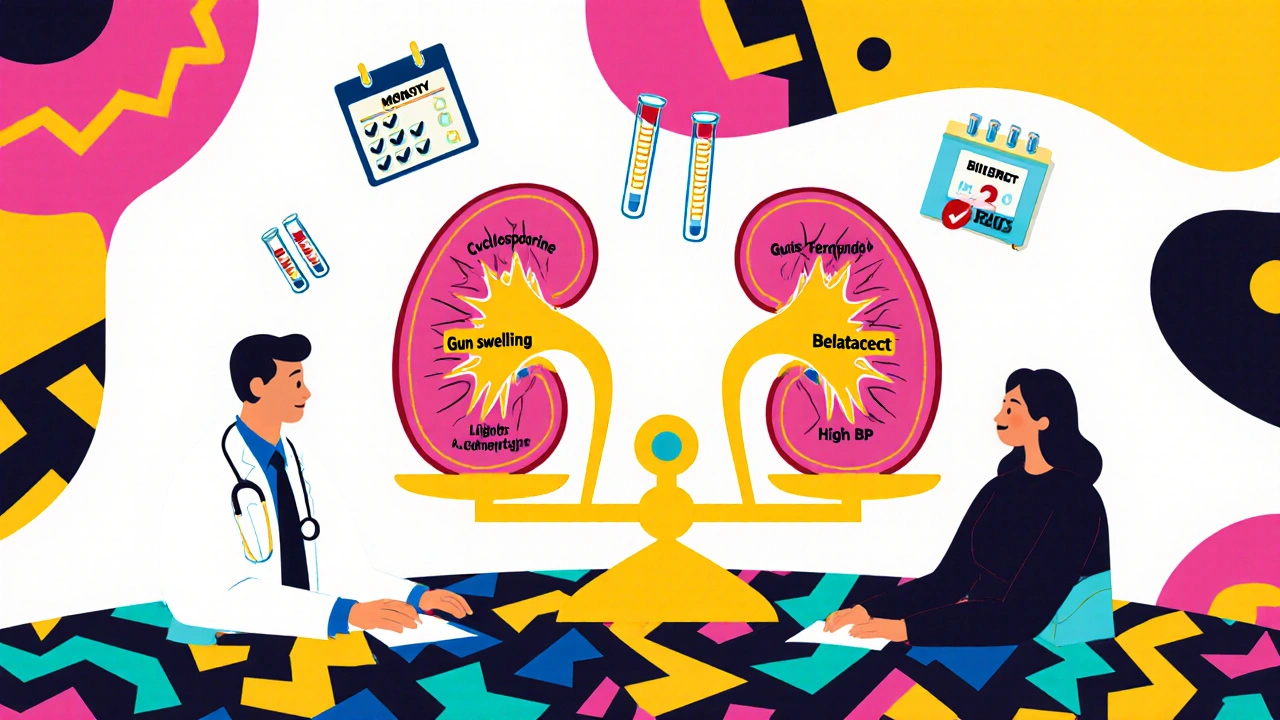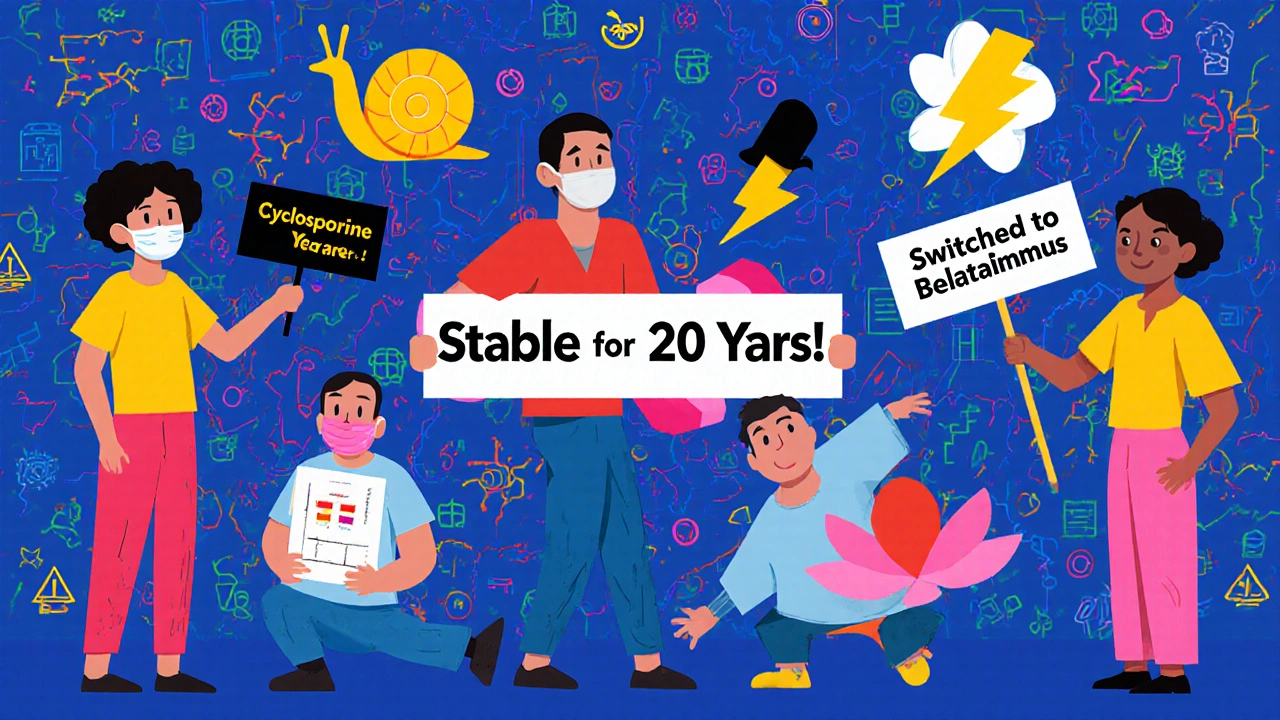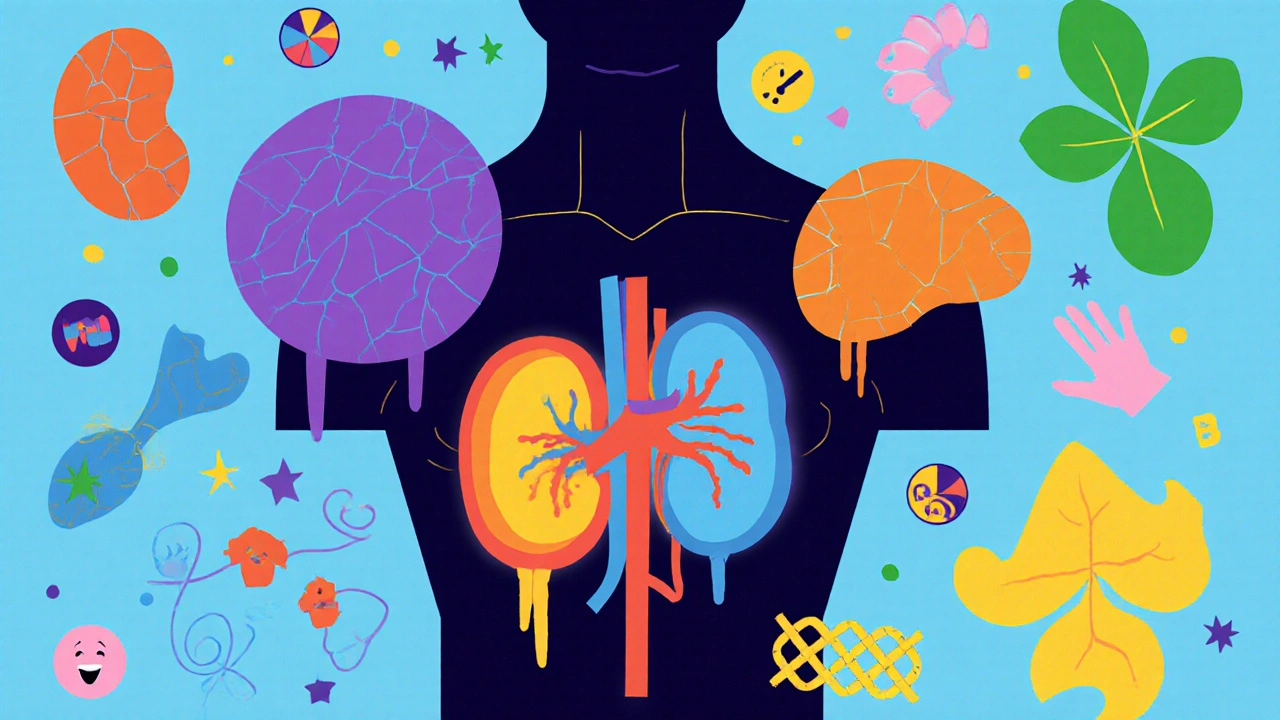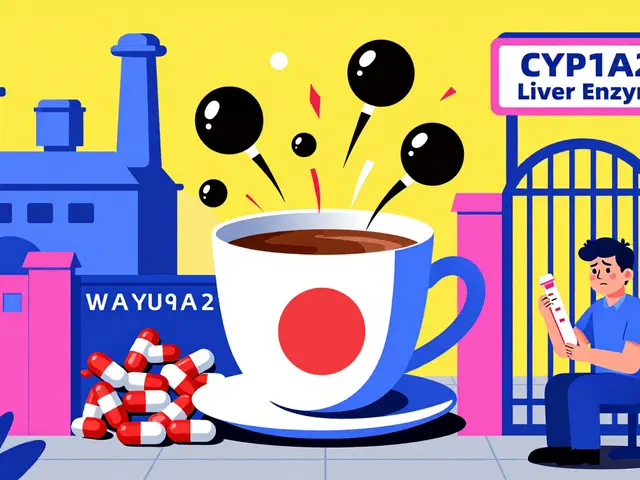Immunosuppressant Drug Comparison Tool
Drug Comparison Parameters
When your body starts attacking its own organs or a transplanted kidney, heart, or liver, doctors reach for immunosuppressants. Cyclosporine has been a go-to for decades. But it’s not the only option anymore-and for many people, it’s not even the best one. If you’re on Cyclosporine or considering it, you deserve to know what else is out there, how they compare, and what real patients experience.
What Cyclosporine Actually Does
Cyclosporine is a calcineurin inhibitor that blocks T-cells from triggering immune attacks. It was first approved in the 1980s and revolutionized organ transplant survival rates. Before Cyclosporine, half of kidney transplant patients lost their new organ within a year. Today, thanks to drugs like this, over 90% still have functioning transplants after five years.
But it doesn’t come without cost. Cyclosporine can raise blood pressure, damage kidneys over time, cause shaky hands, and make gums swell. Long-term use increases the risk of skin cancer and infections. Many patients describe it as a trade-off: keep your organ, but deal with side effects that feel like a new illness.
Tacrolimus: The Most Common Replacement
If your doctor switches you off Cyclosporine, it’s most likely to tacrolimus. It’s stronger, works faster, and often requires lower doses. In head-to-head studies, tacrolimus cuts acute rejection rates by nearly 30% compared to Cyclosporine in kidney transplant patients.
But here’s the catch: tacrolimus is more likely to cause diabetes. About 15-20% of patients develop new-onset diabetes after transplant when taking it, compared to 5-10% on Cyclosporine. It also causes more tremors and insomnia. Some people feel jittery or can’t sleep for weeks after switching. Others swear it’s the only thing that keeps their body from rejecting the transplant.
For many, the decision comes down to this: do you want fewer rejections (tacrolimus) or fewer metabolic side effects (Cyclosporine)? There’s no universal answer-it depends on your age, weight, family history of diabetes, and how your body reacts.
Sirolimus: For Patients Who Need to Avoid Kidney Damage
If your kidneys are already struggling, or you’ve had kidney damage from long-term Cyclosporine use, sirolimus might be your next move. Unlike Cyclosporine or tacrolimus, sirolimus doesn’t harm kidney tissue. It works by blocking a different pathway in immune cells-mTOR inhibition-instead of calcineurin.
Studies show patients switched from Cyclosporine to sirolimus after a year post-transplant had better kidney function scores two years later. Some even saw their eGFR numbers climb back up.
But sirolimus has its own problems. It causes mouth sores in up to 40% of users. It raises cholesterol and triglycerides. And it can lead to lung inflammation in rare cases. You also can’t take it with grapefruit juice or certain antibiotics. It’s not a first-line drug, but for patients with declining kidney function, it’s often the only safe option left.

Mycophenolate: The Support Player
You rarely take mycophenolate alone. It’s usually paired with Cyclosporine, tacrolimus, or sirolimus. Mycophenolate stops immune cells from multiplying. It’s great at preventing rejection without directly damaging organs.
Side effects? Mostly stomach issues: nausea, diarrhea, vomiting. About 1 in 5 patients have to reduce their dose or stop because of it. But it doesn’t raise blood pressure or cause kidney toxicity. That makes it a favorite for long-term maintenance therapy.
Some transplant centers now use mycophenolate as the backbone of immunosuppression and reduce or eliminate Cyclosporine entirely. This approach, called calcineurin inhibitor minimization, is growing in popularity because it cuts long-term organ damage without increasing rejection risk.
Belatacept: The New Kid on the Block
Belatacept is the newest option-and the only one that doesn’t touch calcineurin at all. It’s an IV drug given once a month after transplant. Instead of poisoning immune cells, it literally blocks their activation signal.
Three-year data from the BENEFIT trial showed patients on belatacept had significantly better kidney function than those on Cyclosporine. Their creatinine levels stayed lower. Their blood pressure was easier to control. And they had fewer cases of chronic kidney disease linked to immunosuppressants.
But belatacept has a big downside: higher rejection rates in the first year. About 20% of patients on belatacept had acute rejection compared to 12% on Cyclosporine. It’s only approved for kidney transplants, not hearts or livers. And it requires regular clinic visits for IV infusions-something not everyone can manage.
It’s not for everyone. But for younger, healthy patients who can commit to monthly visits, it’s becoming a top choice for long-term health.
Why Some Patients Stay on Cyclosporine
Not everyone switches. Some people have been on Cyclosporine for 15, 20, even 30 years and feel fine. Their numbers are stable. Their organs are working. Their side effects are manageable.
Cost matters too. Generic Cyclosporine can cost under $50 a month in Australia. Tacrolimus and belatacept cost hundreds, sometimes over $1,000 a month without subsidy. Even with the PBS, some patients pay hundreds out of pocket.
And then there’s fear. Switching drugs means uncertainty. What if the new drug doesn’t work? What if rejection happens? For older patients or those with complex medical histories, staying on what’s familiar can feel safer-even if it’s not the healthiest choice long-term.

How Doctors Decide What’s Right for You
There’s no checklist that fits everyone. But most specialists follow a rough pattern:
- First year post-transplant: Usually tacrolimus or Cyclosporine, often with mycophenolate.
- After year one: If kidney function drops or side effects get bad, they consider switching to sirolimus or belatacept.
- If you have diabetes risk: Avoid tacrolimus; Cyclosporine or belatacept might be better.
- If you have high cholesterol: Avoid sirolimus; mycophenolate + low-dose tacrolimus could be safer.
- If you’re young and active: Belatacept offers the best long-term organ protection.
Regular blood tests are key. Doctors watch your creatinine, blood sugar, cholesterol, and drug levels. They don’t just look at the numbers-they ask how you feel. Do you have headaches? Trouble sleeping? Swollen gums? A sudden rash? Those details matter more than any lab result.
What Patients Wish They Knew Sooner
From talking to transplant patients across Perth and Melbourne, common regrets come up again and again:
- "I didn’t know Cyclosporine could hurt my kidneys over time-I thought it was just for rejection."
- "I stayed on it because I was scared to switch. By the time I did, my kidneys were already damaged."
- "No one told me about the mouth sores with sirolimus. I thought I was getting sick."
- "I thought belatacept was only for rich people. Turns out, I qualified for the subsidy."
The biggest takeaway? Don’t accept side effects as normal. If you’re on Cyclosporine and you’re tired all the time, your gums bleed, or you’re constantly on blood pressure meds, talk to your doctor. There are better options-and they might be closer than you think.
Final Thoughts: It’s Not About the Drug, It’s About You
Cyclosporine saved lives. But medicine doesn’t stand still. Today’s alternatives offer better long-term outcomes for many people. The goal isn’t just to keep your organ alive-it’s to help you live well, without constant side effects, without diabetes, without kidney damage.
Ask your doctor: "What’s my risk of kidney damage if I stay on this?" "What are my options if I want to reduce side effects?" "Is there a drug that protects my organs longer?"
There’s no perfect drug. But there’s a better one-for you.
Is Cyclosporine still used today?
Yes, but less often than before. Cyclosporine is still prescribed for patients who can’t tolerate newer drugs, can’t afford alternatives, or have been stable on it for years. Most transplant centers now use it only when other options aren’t suitable due to cost, side effects, or medical history.
Can you switch from Cyclosporine to tacrolimus safely?
Yes, switching is common and usually safe if done under medical supervision. Doctors lower Cyclosporine slowly while introducing tacrolimus, monitoring blood levels closely. Rejection risk is low when the transition is managed properly. Many patients report feeling better after switching, especially if they had gum swelling or high blood pressure from Cyclosporine.
Which drug has the least kidney damage?
Belatacept and mycophenolate cause the least kidney damage over time. Sirolimus also spares kidney tissue but can cause other issues like high cholesterol. Cyclosporine and tacrolimus are both linked to chronic kidney injury with long-term use. For patients worried about long-term kidney health, avoiding calcineurin inhibitors (Cyclosporine and tacrolimus) is often the best strategy.
Does mycophenolate replace Cyclosporine?
Not alone. Mycophenolate is almost always used with another immunosuppressant. It’s great at preventing rejection and doesn’t harm kidneys, but it’s not strong enough by itself to stop acute rejection in high-risk patients. It’s most often used to reduce or replace Cyclosporine as part of a combination therapy.
Are there natural alternatives to Cyclosporine?
No. There are no proven natural alternatives that can safely prevent organ rejection or control severe autoimmune diseases like lupus or psoriasis. Supplements like turmeric or fish oil may help reduce inflammation, but they cannot replace prescription immunosuppressants. Stopping your medication for herbal remedies can lead to organ failure or life-threatening flare-ups.
How often do you need blood tests when on Cyclosporine?
At first, you’ll need blood tests every 1-2 weeks to check drug levels and kidney function. Once stable, it drops to every 4-8 weeks. But if you switch drugs, start new medications, or get sick, your doctor will likely order more frequent tests. Drug levels can change quickly-what worked last month might be too low or too high this month.



October 28, 2025 AT 04:25 AM
I switched from cyclosporine to tacrolimus last year and honestly? My gums stopped bleeding and I can finally sleep through the night. The tremors suck but I’d rather shake than bleed out from rejection.
October 28, 2025 AT 07:50 AM
It’s fascinating how we’ve reduced human biology to a series of chemical trade-offs, isn’t it? We trade kidney function for organ survival, sleep for stability, and dignity for dosage charts. Is this medicine-or just advanced damage control dressed in white coats?
October 28, 2025 AT 21:47 PM
Oh wow, so the drug that keeps your new kidney alive also gives you gum disease and skin cancer? Groundbreaking. Next you’ll tell me oxygen causes aging. Thanks for the 2005 medical textbook recap, OP.
October 30, 2025 AT 07:02 AM
Bro in India we still use cyclosporine because tacrolimus costs more than my monthly rent. My cousin got a liver transplant 8 years ago on generic cyclosporine-still alive, still working as a driver, no diabetes. Sometimes the old way is the only way. Not everyone has insurance or a trust fund
November 1, 2025 AT 00:16 AM
My dad’s been on mycophenolate + low-dose tacrolimus for 12 years. His kidneys are better than mine. He still gets nausea but he’s alive. That’s the win.
November 1, 2025 AT 07:46 AM
Belatacept? That’s just a fancy IV drip for rich people who don’t wanna take pills. Also why is no one talking about how the trials were funded by pharma? Of course it looks good on paper.
November 3, 2025 AT 05:51 AM
Let’s be real: the entire transplant industry is built on keeping people dependent on drugs that cost more than their cars. Belatacept? Sure, it’s ‘better.’ But it’s also a $1200/month subscription to a clinic. Meanwhile, cyclosporine? $45. That’s not medicine-that’s economic coercion.
November 5, 2025 AT 00:02 AM
They say sirolimus spares kidneys but did anyone check if it makes you hallucinate? My uncle got on it and started seeing spiders on the ceiling. They said it was 'stress' but I think it was the drug. Also, grapefruit juice? That’s just a warning label for people who don’t read.
November 6, 2025 AT 11:34 AM
This is such a helpful breakdown. I wish more doctors explained it like this. No one ever told me my fatigue wasn’t just 'normal post-transplant tiredness.' Thanks for validating what so many of us feel.
November 8, 2025 AT 07:28 AM
There’s a secret protocol. The FDA doesn’t want you to know, but cyclosporine was originally designed as a fungal toxin to suppress dissent in Cold War-era Eastern Bloc hospitals. The side effects? Intentional. It’s behavioral control disguised as medicine.
November 8, 2025 AT 12:42 PM
You got this. Seriously. If you're thinking about switching, talk to your doc. Don't wait until your kidneys are toast. I was scared too. Now I'm hiking in Colorado. Life's still hard, but it's worth it 💪
November 9, 2025 AT 04:54 AM
My doctor switched me to belatacept. Now I have to drive an hour every month to get an IV. Meanwhile, my neighbor on cyclosporine just picks up his pills at the corner pharmacy. Who’s really living better?
November 10, 2025 AT 00:02 AM
It is patently evident that the contemporary paradigm of immunosuppressive pharmacotherapy is predicated upon a neoliberal commodification of biological integrity, wherein patient autonomy is subordinated to institutional profit motives under the guise of clinical efficacy. One must interrogate the epistemological foundations of these so-called 'alternatives'.
November 11, 2025 AT 02:25 AM
And yet, here we are-still debating whether to poison the kidney or poison the pancreas. The real question isn’t which drug is better. It’s why we’re forced to choose between two forms of slow death.